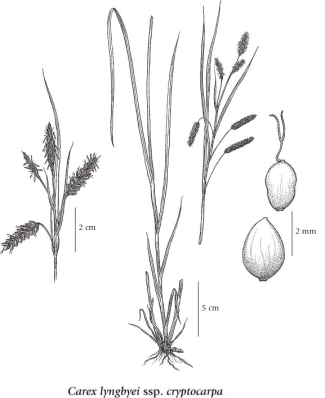Click on the image below to view an
expanded illustration for this species.

|
General:
Perennial herb from long, creeping rhizomes; stems 15-150 cm tall, arising singly or in small clumps, longer than the leaves.
Leaves:
Sheaths tight; ligules as long as wide; blades 4 to 8 per stem, flat, the margins rolled-under, borne on the lower 1/2 of the stem, 2-12 mm wide, the lower ones reduced, persistent.
Flowers:
Spikes 4 to 7, the terminal 2 or 3 linear, 1.5-5 cm long, long-stalked, with many male flowers, the lower spikes 2 to 4, narrowly cylindrical, 1.5-5 cm long, with female flowers, or some with male flowers above the female flowers, short-stalked, usually spreading or nodding; bracts subtending the lowest spike leaflike, sheathless or short-sheathing, the lowest longer than the inflorescence.
Fruits:
Perigynia elliptical to broadly egg-shaped, 2.5-3.5 mm long, 1-1.2 mm wide, yellowish-green or brown, somewhat inflated, smooth, shiny, 2-ribbed, the bases round, short-stalked, the beaks short, 0.1-0.3 mm long, entire or nearly so; female scales lanceolate to egg-shaped, long-pointed or awned, narrower than and exceeding the perigynia, purplish-brown, with 3-nerved, lighter centres and narrow, translucent margins; stigmas 2; achenes lens-shaped, minutely pimpled, sometimes with deep constrictions, 1.9-2.4 mm long.
Source: The Illustrated Flora of British Columbia
|
